Widow's Son, page 3
This page continues the detailed account we found about the "Two Lands" of Egypt.
The daughter of Abraham's son Ishmael and his wife Mahalath was Bashermath. Ishmael is Sarah's son by her maidservent, Hagar an Egyptian. Genesis 25:12. Ishmael lives on the border of Egypt at Havilah and Shur. Genesis 26:35 says Esau married Basemath but she is called the daughter of Elon the Hittite. Esau then married Mahalath the sister of Nebaioth - Genesis 28:9. Note: The two Bible entries concerning Esau's wives disagree about the names of the wives and their fathers: see Genesis 26:34 and 36:1-3. Mahalath was also called Nefru-sobek, an Egyptian name usually chosen for a Queen or a member of royality. Mahalath was also known as Nefru-sobek, a daughter of Pharaoh Amenemhet II and granddaughter of Senusret I, the half-brother of Abraham's wife Sarah. The 'Nefru-sobek' is the same as the Egyptian name Sokebneferure.
Dragon Queen of Egypt 1785-82 BC., Sobeknefru was the last ruler of Egypt's 12th dynasty, and her name meant 'Beautiful of the god Sobek'. Queen Sobeknefru had formalized the Dragon Court of Ankhfn-khonsu establishing a firm base for the priestly pursuits associated with the scientific teachings of Thoth who had prevailed from the second dynasty of Nimrod's grandson King Raneb...
Sobek was the mighty crocodile - the very spirit of Messeh,
whose great temple was erected at Kiman Faris by Queen Sobeknefru's father.
The mighty crocodile and the dragon are symbols of 'wisdom' just as the
snake or serpent represented in Genesis.
parts from Genesis of the Grail Kings, page 210.
"...Irrespective of the Bible's dismissal of the Egyptian descent from Esau to Queen Sobeknefru, the Old Testament writers did acknowledge the Lilithian heritage of the line to his wife Bashemath.
"Nefrusobek", ca. 1790 - 1786 B.C. (Queen - Sebeknefrure or Sokebneferure), was the last ruler of Dynasty 12. (Different web pages have different dates of rule.) The daughter of Amenemhat III, she may have succeeded or displaced her brother Amenemhat IV. She was recognized by the ancient Egyptians in their kinglists as a legitimate ruler and she assumed the full royal titulary, but was always represented as a woman. She built monuments throughout Egypt and her rule was recognized as far south as Lower Nubia.
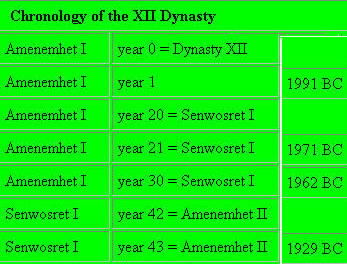 Before the 13th dynasty all
indications are that the Kings lived in the Upper region of Egypt.
Heliopolis is one of the places they lived. Memphis was another. The
cronology page
by Dr. Kelley L. Ross lists the 16th and 17th dynasties as being at Thebes while
the 13th is listed as being at Memphis and Thebes. This is due to the city of Memphis
at that time being far to the North of Thebes. see the map below.
Before the 13th dynasty all
indications are that the Kings lived in the Upper region of Egypt.
Heliopolis is one of the places they lived. Memphis was another. The
cronology page
by Dr. Kelley L. Ross lists the 16th and 17th dynasties as being at Thebes while
the 13th is listed as being at Memphis and Thebes. This is due to the city of Memphis
at that time being far to the North of Thebes. see the map below.
The table to the left below shows the Thebian dynasty and indications are that they lived North of the main capitol at Thebes and were there during the 13th dynasty.
The XII Dynasty kings, none of whose mummies have survived, seem the most human of all the Egyptian kings -- the divine king as the "Good Shepherd." Indeed, it was during the Middle Kingdom that the cult of Osiris was extended from the king to all Egyptians, with a promise of immortality and a happy afterlife for all.
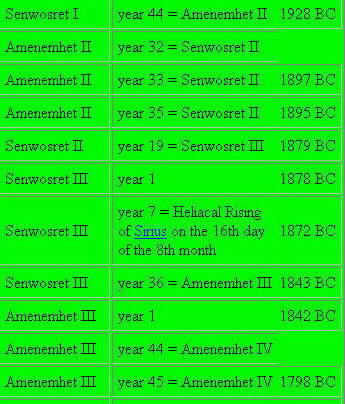 The XII Dynasty is well know for its system of regencies, so many reigns overlap.
The last year is given for each reign, with overlaps. The
Dynasty ends with the reign of Queen Sebeknefrure (or Sokebneferure), one of
three women who are known to have occupied the throne of Ancient Egypt
(not counting Greek Queens like Cleopatra ), though nothing
otherwise is known about Sebeknefrure or her reign except for what is
mentioned above.
The XII Dynasty is well know for its system of regencies, so many reigns overlap.
The last year is given for each reign, with overlaps. The
Dynasty ends with the reign of Queen Sebeknefrure (or Sokebneferure), one of
three women who are known to have occupied the throne of Ancient Egypt
(not counting Greek Queens like Cleopatra ), though nothing
otherwise is known about Sebeknefrure or her reign except for what is
mentioned above.
King Senusret ( Senwosret ) was a XII dynasty Thebian pharoah. We can verify where he
lived because the king is attested at many temples in the Egypt (Hierakonpolis,
Denderah, Abydos, Heliopolis, Bubastis, Medinet el Fayum.)
Senusret is thought to have reigned for the first ten years in a coregency
with his father Amenemhat (Amenenhet I) if so, the start
of his reign (and of the co-regency) seems to be the point at which a new
Residence city was founded at Lisht, and the
Pyramid of Amenemhat I was begun.
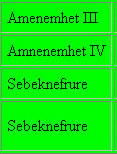
 Senwosret founded a new administrative centre for the country on the border
of Upper and Lower Egypt, with the name Itjtawyamenemhat 'Amenemhat is seizer
of the two lands' (usually shortened to Itjtawy, and probably located near the Nile
in the area of modern Lisht, where the king had his pyramid complex built).
Senwosret founded a new administrative centre for the country on the border
of Upper and Lower Egypt, with the name Itjtawyamenemhat 'Amenemhat is seizer
of the two lands' (usually shortened to Itjtawy, and probably located near the Nile
in the area of modern Lisht, where the king had his pyramid complex built).
Queen Sobekkare - Nefrusobek - 1763 - 1759
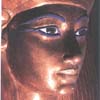 "...Before following the lines of descent from Jacob, it
is worth considering the legacy of Esau, whose descendants
carried an immediate Dragon heritage by way of his wife
Bashemath.
"...Before following the lines of descent from Jacob, it
is worth considering the legacy of Esau, whose descendants
carried an immediate Dragon heritage by way of his wife
Bashemath.
The date of Senwosret III's rule shown here is 1878 to 1843 BC. According to the cronology page, Egypt was not a split nation during this time. A ruling class not connected with the Hyksos was in place before the Hyksos invasion. One of the Northern capitols was Heliopolis, also called 'On'. Conformation of the 'split nation' which may have refered to the Avaris Kings, comes to us in the form of his statement that he will reunify the two-lands.
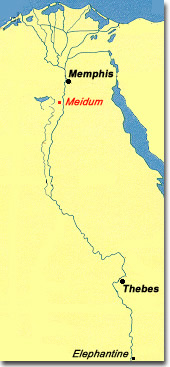 When Amenemhat I came to power, he left Thebes and founded a new capital,
somewhere in the north. This new capital, which he named Itj-Tawi, "the one that
seizes the Two Lands", has never been located. The fact, however, that almost every king
of the 12th Dynasty built his funerary monument near the Fayum oasis, has led to the
assumption that Amenemhat's new capital must have been located somewhere near that oasis.
Amenemhat I's funerary monument can be found near the modern-day village of el-Lisht,
a site located to the south of Dashur not far away from Meidum. Meidum is located some
80 kilometres to the South of Memphis, on the Westbank of the Nile, to the East of
Lake Moëris and the Fayum oasis. It is not unreasonable
to assume that he choose this site because it was near to his new capital, all the more
so since he was followed in this by his successor, Sesostris I.(Khakhaure)
1926 B.C. He fixed the southern boundary of Egypt above the Second Cataract
of the Nile, not far from Wadi Halfa and curbed the power of the Egyptian nobles.
When Amenemhat I came to power, he left Thebes and founded a new capital,
somewhere in the north. This new capital, which he named Itj-Tawi, "the one that
seizes the Two Lands", has never been located. The fact, however, that almost every king
of the 12th Dynasty built his funerary monument near the Fayum oasis, has led to the
assumption that Amenemhat's new capital must have been located somewhere near that oasis.
Amenemhat I's funerary monument can be found near the modern-day village of el-Lisht,
a site located to the south of Dashur not far away from Meidum. Meidum is located some
80 kilometres to the South of Memphis, on the Westbank of the Nile, to the East of
Lake Moëris and the Fayum oasis. It is not unreasonable
to assume that he choose this site because it was near to his new capital, all the more
so since he was followed in this by his successor, Sesostris I.(Khakhaure)
1926 B.C. He fixed the southern boundary of Egypt above the Second Cataract
of the Nile, not far from Wadi Halfa and curbed the power of the Egyptian nobles.
Heliopolis, "city of the sun" in Greek, was situated in the area of Tell Hisn on the northwestern outskirts of modern Cairo. The ancient Egyptian name was Iunu, or iwnw, meaning pillar. Today it is largely covered by the suburbs of Cairo at el-Matariya and Tell Hisn. It is not situated on the bank of the Nile, but lay inland, to the west of the river, and was connected thereto by an ancient canal.
Heliopolis, or 'On' in Coptic, was the capital of the 13th Lower Egyptian nome. By the time of the Old Kingdom, the city was a center of astronomy as reflected in the title of its high priest, wr-m3w, "Chief of Observers" or "Greatest of Seers. This title was held by Imhotep during the 3rd Dynasty reign of King Djoser Netjerikhet, and dates earlier to the reign of Khasekhemwy in the 2nd Dynasty.
“On.” We are told by most reference books that 'On' represented the worship of the sun god. Originally, On was called “Beth Shemesh” (House of Shem). It was not until the time of Akhenaten that a temple was built to Aten the sun god. We find the documentation for this in the book , The Boehm Journey To Egypt, Land Of Tutankhamun by Frank J. Cosentino, page 48:
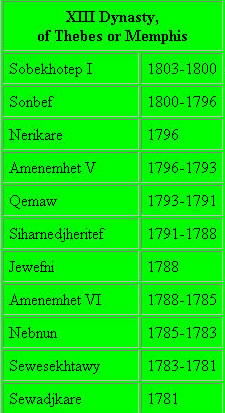
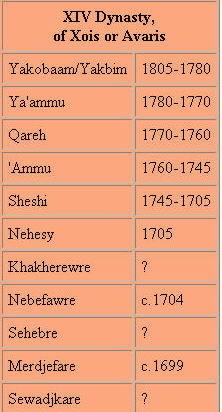 The rise of the Hyksos to power was a turning point in the history
of the Ancient Near East. They took control over the Northern capital of
Memphis
in 1805 BC and founded the 14th Dynasty which ran
parallel to the 13th Dynasty of Thebes-- with a dynasty of vassal
chiefs under Hyksos control. The conquerors were mainly Semites either
from Canaan or from Syria -- the latter having been displaced from their
homeland by the influx of the warring Anatolians from Asia Minor. Avaris or
Tell (mound) Daba in the northeastern part of the Delta was the capital
of the Hyksos. Their fortified
city was built over a Middle Kingdom town they had captured. They built
a Canaanite style temple and had Palestinian style burials there including
burials of horses. They also brought with them such elements of Palestinian
culture as their superior weapons and their type of pottery although they
were to a certain extent [to become] Egyptianized.
The rise of the Hyksos to power was a turning point in the history
of the Ancient Near East. They took control over the Northern capital of
Memphis
in 1805 BC and founded the 14th Dynasty which ran
parallel to the 13th Dynasty of Thebes-- with a dynasty of vassal
chiefs under Hyksos control. The conquerors were mainly Semites either
from Canaan or from Syria -- the latter having been displaced from their
homeland by the influx of the warring Anatolians from Asia Minor. Avaris or
Tell (mound) Daba in the northeastern part of the Delta was the capital
of the Hyksos. Their fortified
city was built over a Middle Kingdom town they had captured. They built
a Canaanite style temple and had Palestinian style burials there including
burials of horses. They also brought with them such elements of Palestinian
culture as their superior weapons and their type of pottery although they
were to a certain extent [to become] Egyptianized. see Cronology 13th - 17th dynasty
Manethô gives six "great" Hyksos kings of the XV Dynasty, but his names in Greek match up only imperfectly with the names known from inscriptions. Although the XIV Dynasty is regarded by Manetho as Egyptian, Ryholt reconstructs it as already Canaanite in origin. By the same token, the XVII Dynasty at Thebes, though called by Manethô a Hyksos dynasty also, was clearly Egyptian.
JOSEPH THE VIZIER
"...We are therefore into the realm of the original
covenant of kingship made with Isaac. His son Esau may have sold
his birthright to his younger brother Jacob-Israel (whose
descendants became kings of Judah), but now we discover that,
through Tuya and Yuya, descendants of Esau did indeed become
pharaohs of Egypt. These particular pharaohs have become known
as the 'Amarna Kings': they are Akhenaten, Smenkhkare,
Tutankhamun and Aye, who ruled consecutively c.1367-1348 BC.
The inscription below the picture reads, "The restored cult
statue of Joseph that once stood near his palace and tomb at
Alvaris in Northeast Egypt".
Covering a time from Abraham to Moses. A most interesting and not much known in Christian Circles, is the History of Yuya/Joseph, son of Jacob, who had become the Vizier of Egypt.
"...it was not until after the Amarna period that the lines from Esau and Jacob were united through marriage, subsequently descending to the Davidic kings of Judah."
So in which court did Joseph become visor and then King? If we take the bible verses at their literal word then we have a conflict and the king Joseph is sold to doesn't know him or his family. We think he is sold to the Hyksos pharoah. Jacob becomes Israel at Genesis 35:, but the translation says, 'Jacob' means he grasps the heel or 'he deceives'. Deceives who?
A point of reference: In the Nag Hammidi texts we find two 'images'
or souls created by Sabaoth. A first born named Israel and Jesus Christ
who resembles the savior above in the eight heaven, who sits at his right on a
revered throne...Israel (the man that sees god) is a deceiver, a false
god worshipper. The thing that had no spirit was 'yalda baoth'. Now when he had
come to have authority over matter, ie., the Earth.
see
'Origin' of the World
The two sons are opposites, one good - one bad. This is only the first clue that
Abraham worshipped a false god.
Matthew 13:35, "I will utter things which have been kept secret from the foundation of the world."
From Isis Unveiled by H. P. Blavatsky, Vol. 1.
"Now, we have but to remember that Siva and
the Palentinian Baal, or Moloch, and Saturn are identical; that
Abraham is held until the present day by the Mahometan Arabs as
Saturn in the Kaaba; that Abraham and Israel were names of
Saturn; and that Sanchoniathon tells us that Saturn offered his
only-begotten son as a sacrifice to his father Ouranos, and
even circumcised himself and forced all his household and
allies to do the same, to trace unerringly the biblical myth to
its source. But this source is neither Phoenician, nor Chaldean;
it is purely Indian, and the original of it may be found in
the Maha-Bharata. But, whether Brahmanical or Buddhistical, it
must certainly be much older than the Jewish Pentateuch."
The Sumerian texts show that Abraham
did follow Enlil/Jehovah and that Enlil is the (false) god who
promised the land of Canaan to Abraham and his decendents.
Genesis 17:8
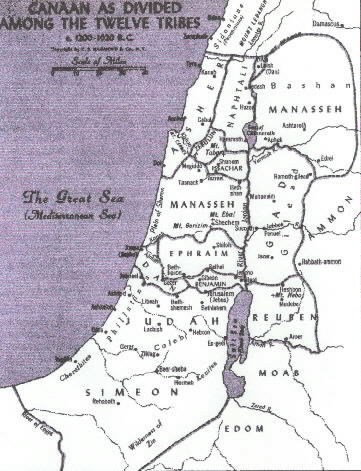 Abraham, nor any of his sons got any land anywhere in Canaan.
Abraham, nor any of his sons got any land anywhere in Canaan.
Jacob marries Leah and Rachel who are described as 'eastern peoples'.
Leah's sons are Simeon and Levi. Jacob moves to Shechem - Genesis 33:18. Does Jacob's
son Joseph have bloodlines that allow him to become pharoah? The question becomes
which king was he sold to? The name Yuya is synonymus with a visor under Tuthmosos
IV (1413-1405BC). Genesis of the Grail Kings says his tomb was discovered in
1905 with his wife Tuya in the Valley of the Kings. The name Joseph does translate
to Yuya...
see Translated names and words
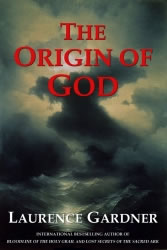 In Laurence Gardner's latest book The Origin of God relates we have something that we can actually
check against the Egyptian annals.
In Laurence Gardner's latest book The Origin of God relates we have something that we can actually
check against the Egyptian annals.
Genesis 45:8 quotes Joseph as saying, ‘God hath made me a father to pharaoh, and lord of all his house, and a ruler throughout all the land of Egypt’. Quite suddenly, we have a major change in the family’s fortune, and a junior member of the line has emerged inexplicably from slavery into a position of great prestige. So the question to be asked is: Was there a Joseph who ruled in Egypt, fathered a pharaoh, and who (as related in the Genesis narrative) would have ridden in the king’s second chariot?’
The answer to each of these questions is ‘Yes’; there was indeed an Israelite Joseph to whom these statements can all be applied. But it was not the same Joseph as in the Bible; their stories are four centuries apart, although the history of the latter was biblically grafted back onto the former to make them appear one and the same.
In consideration of this, we discover precisely why the book of Genesis ends with its account of Joseph in Egypt, whilst the following Old Testament book of Exodus begins with the story of Moses and the Israelites in much later times. It also becomes evident why (from the list of Jacob-Israel’s twelve sons) there was never a Tribe of Joseph. instead, the twelfth tribe was seemingly formed as a combination of Ephraim and Manasseh, who were said to have been Joseph’s sons by Asenath, the daughter of Potiphar, a priest of the city of On.
From evidence in the Egyptian records, it emerges that Joseph, the biblical son of Jacob, was moved literally from the company of his brothers by the writers of Genesis in order to link him with a prominent nobleman called Joseph (Yusuf) in Egypt sonic twelve generations later. In this regard, the introduction o[ Potiphar was conveniently suited to identifying the biblical Joseph with later namesake who, at the age of thirty-three, did indeed marry the daughter of Poti-phera (Pa-di-pa-ra: ‘Gift of the god Ra’).
An interesting aspect of the biblical scenario is the story Joseph’s attempted seduction by Potiphar’s wife. (The wife the historical Potiphera of later times was said to have been called Zelekah.) When the biblical Joseph refused to submit her wiles, the woman ripped his garment from him and presented it to her husband, claiming that she had narrowlv escaped heir assaulted by Joseph. Until a few decades ago, there appeared nothing untoward about this discreet little tale. But then Egyptologists translated a hieroglyphic document called t Orblney Papyrus from 19th—dynasty Egypt (ci 250 BC). In this transcript they discovered the story’s original prototype within the romantic lore of Egypt. It recalled the unfortunate experience of a young man called Ba ta, and had nothing whatever to do with Joseph or Zelekah.
Attaching the dubious story of Potiphar’s wite to the biblical Joseph, with the result that he was cast into prison, enabled the Genesis scribes to relate how (visited in his cell by the pharaoh’s cup-bearer) Joseph became known as one who could decipher dreams. This led not only to joseph’s release, but to his interpreting dreams of the pharaoh, which prophesied a great famine. Consequently, Joseph was placed in charge of laying-up preparatory stores and received high promotion within the royal court. ‘l’his brought his literary status to the strategically required level for association thereafter with Joseph the Vizier of much later times.
Genesis explains that eventually, as a result of the famine which spread into Canaan, Jacob—Israel and his family — numbering seventy in all - came to seek Joseph’s aid in Egypt. He established for them a settlement in the Nile delta country of Goshen, and God qualified the words of his covenant with some additional information: ‘Fear not to go down into Egypt, for I will there make of thee a great nation’ .Henceforth, these erstwhile Hebrews and their descendants in Egypt became known as Israelites, or ‘children of Israel’. Meanwhile, back in Canaan, the Hebrew legacy continued in parallel with the descendants of Ishmael and Esau becoming notable lords in the region.
The Grand Vizier
Eighty miles (c.129 cm) south of modern Cairo is the town of Medinet-el-Faiyim, where a 200-mile (322 kin) canal has long transformed the desert into a lush garden paradise of fruit groves. Originally a meandering branch of the Nile with a deep lake depression called the Paipim, work began in the reign of Amenhotep 111 (c.1405 1367 BC:) to transform it into a functional waterway for irrigation. To the local residents (the Fellahin) and throughout Egypt, the ancient waterway is traditionally known as Bahr Yusuf (Joseph’s Canal), and was named after Joseph the Grand Vizier.
In cementing the scriptural link between the two Josephs, Genesis 41:39-43 tells how the biblical Joseph was made Governor of Egypt:
And Pharaoah said unto Joseph ... Thou shalt be over my house, and according to thy word shall all my people he ruled; only in the throne will I be greater than thou ... And he made him ruler over all the land of Egypt.
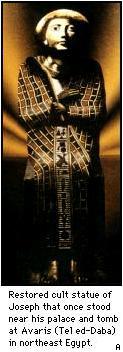 It is also stated in the very last verse of Genesis that, when Joseph
died, he was embalmed like a pharaoh and this was precisely
the historical case with Yusuf the later Viziei; who was indeed
mummified and entombed in a fine sarcophagus in no less a place
than the royal burial ground: the Valley of Kings at Western
Thebes (modern Luxor).
It is also stated in the very last verse of Genesis that, when Joseph
died, he was embalmed like a pharaoh and this was precisely
the historical case with Yusuf the later Viziei; who was indeed
mummified and entombed in a fine sarcophagus in no less a place
than the royal burial ground: the Valley of Kings at Western
Thebes (modern Luxor).
Yusuf was the principal minister for the 18th-dynasty pharaoh Tuthmosis IV (c:1413 1405 BC), and for his son Amenhotep Ill. Yusuf’s tomb was discovered in 1905, along with that of his wife Tjuyu, and their mummies are now among the very best preserved in the Cairo Museum.
It came as a great surprise to Egyptologists that anyone outside the immediate royal family should have been mummified and buried in the Valley of Kings. Clearly, this couple had tremendous importance in their day. Yusuf’s funerary papyrus refers to him as ‘The Holy Father of the Lord of the Two (it ntr n nb tawi), as does his royal funerary statuette. The ‘Lord of the Two Lands’ was a pharaonic distinction related the kingdoms of Lower and Upper Egypt,’ and it is plain that Yusuf was not only the viceroy and primary State official, but also the father of a pharaoh (just as attributed to the biblical Joseph). He even held some personal kingly status, as determined by his own equally pharaonic designation: ‘One trusted good god in the entire land’.
The family of Yusuf was very influential, holding inherited property in the Nile delta, and he was a powerful military leader.’ Anen, the elder son of Yusuf and Tjuyu, also rose to office under Amenhotep Ill as Chancellor of Lower Egypt, Priest of Heliopolis and Divine Father of the Nation. But it their younger son, Aye, who held the special distinction, ‘Father of the God’,’and became Pharaoh in about 1352 BC.
Not only was Yusuf of individual royal significance, but was his wife Tjuyu. She held the special distinction of A (iw s-n-t) a style which derives from an 18th-dynasty Egypt dialect, and means ‘Belonging to the goddess Neith’.Tjuyu the daughter of Poti-phera, a priest of Heliopolis and, according to the Corpus of Hieroglyphic Inscriptions at the Brooklyn Museum she was the designated King’s Ornament (kheret nesw). Albeit by a strategically fashioned scribal manipulation or time-frames (with two Josephs nearly half a millennium apart), it seems that we are now discovering the Egyptian aspect of the Bible’s two-part covenant prophecy for it was indeed Asenath, the daughter of Potiphar, a priest of On (Heliopolis), whom Genesis 41:45 spuriously identifies as the wife of the biblical Joseph more than four centuries earlier
A Myth of Remembrance
The British anatomist, Grafton Elliot Smith, who examined yusuf’s mummified remains after their excavation, reported that his head shape is by no means a common one in the pure Egyptian’. He was ultimately of Israelite descent - hence his Hebrew name Yusuf (Joseph). It had therefore been possible for the Bible writers expediently to close up the time-gap between him and the much earlier Joseph, son of Jacob-Israel.
The pharaohs in descent from Yusuf and Tjuyu have become known as the Amarna Kings; they were Akhenaten, Smenkhkare, Tutankhamun and Aye. Their short reigns were consecutive (c.1367- l338 BC) and, although the two Josephs were separated by 400 years, it is possible that they were genealogically connected, with the latter in descent from the former. If so, the Amarna Kings would certainly fit the prophesied El Shaddai covenant of Egyptian kingship made with Abraham and Isaac. It is rather more likely, however, that the biblical Joseph if he truly existed by that name never went to Egypt. It must be remembered that, of all Jacob-Israel’s twelve sons, Joseph is the only one not to have had a Tribe named after him. From their latter-day knowledge of Yusuf the Vizier, however, the ‘Joseph’ name would have been well suited for use by the Genesis scribes in order to cover an inconsequential period of Israelite history and move swiftly from the time of Abraham to the time of Moses.
From the 18th-dynasty campaigns of Pharaoh Tuthmosis III (c.1490-1436 BC), the land of Canaan had been placed under Egyptian rule, and remained so into the era of the Amarna Kings. The American Egyptologist, James Henry Breasted of the Oriental Institute, referred to Tuthmosis Ill as the ‘Napoleon of Egypt’, and the empire (from Syria to Western Asia), established by him and his son Arnenhotep II, was indicative of the kingly domain promised to the descendants of Isaac, ‘from the river of Egypt, unto the river Euphrates’
From the outset of Yusuf’s sarcophagus discovery, Egyptologists were intrigued by its unusual hieroglyphics. In one by one way or another, Egyptian tomb inscriptions were generally related to the godhead under which the occupant was placed life, revealing such deiform names as Ra, Amen, Thut and Ptah. But Yusuf’s identification did not relate to any known god of Egypt. instead, it was obscure, seemingly conveying a name such as Yawa or Yuya. It even became common practice to refer to Yusuf himself as Yuya, and he is often referenced as such today. With knowledge of Yusuf’s israelite heritage, the mystery of Yuya was ultimately revealed in the records of Yusuf and Tjuyu's daughter Tiye. She had married Pharaoh Amenhotep III to become a Queen of Egypt and, as we saw in chapter 7, it was in the unearthed library of Amenhotep Ill that a Mesopotamian Adapa Tablet concerning Enki, NIn-kharsag and the creation of Adam was discovered in 1917.
Tiye’s influence on Amenhotep III was great and, upon her marriage, the ancestral god of her Israelite culture was brought into the Egyptian pantheon. Yuya, it transpired was none other than El Shaddai who, after 400 years, had become known to the prevailing Israelites of Goshen as ‘He who lives’. Stemming from the verbal root, hayah (‘to live’), he was referred to as lauiya or Yaouai — phonetically, ‘Yahweh’.
At this stage of Israelite history in Egypt, we are just one generation removed from Moses. Thus it was that, when Moses led the exodus into Sinai, the godlly heritage that travelled with them was that of Yaouai, and the identification of God by the style of ‘Yahweh’ moved into common usage beyond the confines of Egypt from that time. In venerative terms, Yaouai was referred to by Israelites as the Adon, a Semitic word meaning ‘Lord’,equivalent to the Egyptian A ten. It is for this reason that, onwards from the time of Moses, the godly distinction of ‘Adon’ appears with some frequency in the Hebrew Bible alongside the more commonly expressed ‘Yahweh’. It is as Adon that Moses first refers to God in Exodus 4:10, when negotiating the possibility of bringing the Israelites out of Egypt.
Upon his marriage to Tiye, Amenhotep III gave her the frontier city of Zarw in the delta land of Goshen, and made her the chief of his wives, even above his first wife, Queen Sitamun. At Zarw, he built the first ‘Temple of the Lord’ (the House of Aten) and excavated an enormous lake on which he placed his royal barge, called Telien Aten (Aten Gleams). The fortified settlement of Zarw was built on the site of the ancient city of Avaris. In later times it was reconstructed to become known as Pi-Rameses in the reign of Rameses II, who had been a mayor of the city.
The essential difference between Aten and the indigenous gods of Egypt was that Aten did not have a personality that Amenhotep could ascertain. There was no associated mythology, no indication of character, nor any romantic lore that could be applied. But for Tiye and the Israelites the perception was somehow different in that Yaouai was deemed to live, albeit that through the period of sojourn his image had dissolved into its own myth of distant remembrance. Nonetheless, Amenhotep’s representation for the Lord emerged as a glorious solar disc with downward rays terminating in hands. Ra was the great sun-god of the Egyptian nation, and the State god was Amen but, during the reign of Amenhotep III, the Aten disc of Yaouai was introduced as being the Light in which they prevailed.
The Genesis Players
Having now reached the end of Genesis with the death, mummification and burial of Joseph, we also emerge from the most colourful and engaging episode of the book. Albeit the story of Joseph was contrived as a personal fiction, it was inspired by a true account of Israelite history to provide a soundly grafted example of racial integration at the highest level, as was applicable in much later times. In parallel with this, however, the retained Yaouai tradition of the Israelites (as has recently been identified from the records of Yusuf, Tjuyu and Tiye) indicate that, even four centuries from the time of Abraham, the Israelite culture in Egypt was still largely Hebraic. Despite the individual professional rise of Yusuf-Yuya and those of his aristocratic circle, however, it is evident that the Israelites were mainly confined to the delta region of Goshen and were treated very much as a lower-ranked society by the Egyptian governors.
The bible says Joseph asked to be taken out of Egypt even though the mummy was placed in a coffin in Egypt. Our picture of Joseph indicates he was buried at Avaris or Tel ed-Daba. And this is confirmation of the real Joseph ending up in Avaris. In the Hyksos stronghold. "Joseph was sold to them, and the Midianites in turn sold him as a bonded slave to Potiphar, head of the Royal Guard at Memphis (Avaris)...which the Hyksos rulers had taken over.
The date he gives was 1683 BC and says Joseph was barely seventeen years old". from Joseph However Gardner also connects him with Pharaoh Amenemhat III as we read above.
As to the location; he was buried at Avaris and the Avaris - Hyksos dynasty as we confirmed and copied here. Amenemhat III, was Thebian and reigned in 1797 BC., 400 years before the biblical Joseph.
Note: Biblical writers would never admit to historical record as being more correct than the bible. Joseph was said to have been king for 6 years when no other heir was in line to rule, but this name is not found on either king list. Our contension is he was not a king under any Thebian dynasty.
In the Halley’s Bible Handbook by Henry H. Halley, page 107, it states: “Joseph Made Ruler of Egypt. Joseph married a daughter of the priest of On; and, though he had a heathen wife, and ruled a heathen kingdom, and resided in a center of vile Idolatry, he maintained his childhood faith in the God of his fathers, Abraham, Isaac and Jacob.”
We are going to have to agree with Halley on Joseph’s wife, for it appears she was of the House of Shem, just as Tamar was (the mother of Pharez and Zarah). Shem was a son of Noah who becomes corrupted and worships Baal. So we do believe that Joseph’s father-in-law was practicing “vile Idolatry”, for he was a priest of “Beth Shemesh.” It is also evident that there were, at least, some Shemites in Egypt during Joseph’s time, and Joseph did marry a heathen as implied! from Letter 31, Children of Yehwah, changed to agree with Halley.
Later when we read the books of Noah, we confirm that Shem is the cause of the reintroduction of heathen Babyloian gods like Baal.
If all the men of Shechem were killed in the story concerning Jacob, Levi and Simeon, this would give the true Egyptians reason to rise up in defence of what they considered their territory. And we pointed out that the broken clay tablet tells a different story than the Hebrew account assumes.
 The assumption is that the
Hebrews were so ashamed of this act that it was not fully explained.
Egyptian historians have concluded that Joseph was a Vizer
to the reigning Hyksos King and recorded history says he served
many Pharoah's and was sole ruler for 6 years when no one
else was in line to be Pharoah under Hyksos rule in
'lower' Egypt. He was married to Asenath, daughter of Potiphera,
Priest of Heliopolis, Genesis 47:19-22. He was buried in
Egyptian style, in an Egyptian coffer with Egyptian decoration
in the form of the 'wings' of Maat...In Egypt..at Avaris.
This confirms his loyality and devotion to the Hyksos rulers
but there was another reason that no one understood until now.
Joseph did worship the 'god of his fathers', Baal.
The assumption is that the
Hebrews were so ashamed of this act that it was not fully explained.
Egyptian historians have concluded that Joseph was a Vizer
to the reigning Hyksos King and recorded history says he served
many Pharoah's and was sole ruler for 6 years when no one
else was in line to be Pharoah under Hyksos rule in
'lower' Egypt. He was married to Asenath, daughter of Potiphera,
Priest of Heliopolis, Genesis 47:19-22. He was buried in
Egyptian style, in an Egyptian coffer with Egyptian decoration
in the form of the 'wings' of Maat...In Egypt..at Avaris.
This confirms his loyality and devotion to the Hyksos rulers
but there was another reason that no one understood until now.
Joseph did worship the 'god of his fathers', Baal.
It says, "Joseph was sold to them, and the Midianites in turn sold him as a bonded slave to Potiphar, head of the Royal Guard at Memphis." "Jacob and many of his family and followers settled in the district of Goshen in northeast Egypt. Jacob himself built his home at Avaris." see The influence of Joseph Note; We confirmed above that the Northern city of Memphis had been taken over by the Hyksos rulers and this site says he lived at Avaris. And we do not agree with the dates used or who the pharoah was at the time but check this out..(Yoséf).
Another point to consider is this; Egyptian names and Hebrew names are different. Moses may have been called ThutMoses in Egyptian, or as Gardner concluded, he may well have been Akhenaten. Enoch is called Imenhotep by the Egyptians and Hermes the Greek god is Thoth, ect. The name the Bible states that was given to Joseph by the pharaoh, is "Zaphenath-paneah", and has been translated by some to mean, "the God lives; the God speaks". There are several works of "wise sayings" attributed to one "Ptahotep" (Imhotep) , who is only known as a vizier of a king from the 5th dynasty. However, there are 5 known "Ptahoteps", all viziers to pharaohs of the 5th dynasty, all priests of Heliopolis, or "On" which was not where the true royal Egyptian families lived. Also under consideration is this; Once the candidate becomes a king, he or she changes his or her name. Joseph was king for 6 years but we do not know what name he chose once he became sole ruler of the northern Memphis.
Evidence seems to indicate that after the wise one called 'Imhotep', who may actually be Enoch, the trend among viziers became patterned after him, with these later viziers taking credit for Imhotep's actual deeds and his writings- a practice which the Egyptians, among others, were notorious for.
After the story of Joseph, nothing more is mentioned about Levi and Simeon in the King James version, except when Jacob declares that, "I will scatter their descendents throughout Israel . Genesis 49:7. This also means shame has come upon the tribes of these two men. This completely contridicts the Geniza Fragments. 'Their names then disappear from the record and they may have been caught and killed by the new King of Egypt, Seqenenre's son, Kamose. At the time of the 'Judges' the tribes of Simeon and Levi had been virtually wiped out and the tribe of Judah had come into prominence. If you recall the tribe of Judah is favored over the tribe of Levi. King David's heirs - Jessie and Solomon are of the tribe of Judah.
Hosea 11:1. When Israel was a child...“Out of Egypt did I call my son.” .
..sacrificing to Baal and burning incense to idols." The rest of this chapter is
also important.
"I am God and not man; I am the Holy One living amoung you, and I did not come
to destroy." verse 12; Israel surrounds me with lies and deceit..but Judah
still trusts in God and is faithfil to the Holy One." Judah is the son of
Abraham who suggested the brothers sell Joseph to the Ishmaelites. Why is Judah
favored here over Israel (Abraham)? Also take note that this God emphasizes
he is Not here to Destroy!
Although the 'priesthood' name of Levi is carried forward, the tribe is gone. It then would depend on which side you favored as to who the Hero was. We don't think it was Joseph.
To back this up, we have this; The right of Omri-Joseph and his house to rule directly over Israel was not fully recognized until the dynasty established by his father in that region was brought to an end. After all six of his elder half-brothers had either died or been disgraced, Omri-Joseph is said to have ruled Israel for 12 years. These 12 years correspond to the final 12 years of the reign of Solomon (Amenhotep III) and the first 12 years of Rehoboam (Amenhotep IV/Akhenaten). These 12 years of direct influence by Joseph over Israel are looked upon with extreme disfavor by the author of the Kings narrative. "Omri did evil in the eyes of the Lord and sinned more than all those before him." Perhaps this is the reason why the latter years of Joseph are not explicitly mentioned in the Torah. We are told in the book of Genesis that Joseph was hated by his brothers. However, we are led to believe that all was forgiven and that Joseph enjoyed a universally celebrated adulthood. Elsewhere in the Torah, Joseph is only mentioned in passing as Reuel, the "friend of God," and father-in-law of Moses. So it comes as some surprise that he continued to be held in contempt, not only by the children of his brothers, but at end of his days, even in the eyes of his own sons.
Omri is a man who needs no introduction. In Chapter 15, it was shown that in the Torah the latter years of Joseph are accounted for under the pseudonym of Reuel. Similarly, in the books of Kings and Chronicles, the aged Joseph is accounted for in the story of Omri, whose name means "Heaping," and "Grain Gatherer." from Translated Names Note; This website does not seperate the Thebian from the Hyksos Dynasties and claims that Jacob is actually Amenhotep II which we and Dr. Kelley Ross (cronology of the dynasties) strongly disagree with..
Reuel is mentioned as Moses father-in-law at Exodus 2:18 and it is stated that he is a priest of Midian. On our Moses page we conclude that Mount Horeb is in Midian and Moses has been there before. His 'running away' to this place is no accident. At Exodus 3:1 Moses father-in-law is called Jethro. If Joseph is Moses father-in-law Reuel, and Moses is a true Egyptian, this clearly puts him at odds with Joseph. However the whole description is at odds because one describes Rauel as evil and the other would make Rauel a priest of the same God as Moses. We think all of the evidence establishes that they did not worship the same god. But it establishes them as living in the same time period as we have theorized.
Documented proof discovered in 1904 by Sir W. M. Flinders Petrie confirms Moses had been to Mt Horeb before. What Petrie, et al, had found was an Egyptian laboratory of Alchemy standards. “And mount Sinai was altogether on a smoke... and the smoke thereof ascended as the smoke of a furnace, and the whole mount quaked greatly.” (Exodus 19:18) Mount Horeb -- by any other name -- was the place where it was happening! It was also off limits to anyone not brought up in the Pharaoh’s lineage (e.g. Moses). “And thou shalt set bounds unto the people round about, saying, Take heed to yourselves, that ye go not up into the mount, or touch the border of it; whosoever toucheth the mount shall be surely put to death.”
In all respects, it appears that Mount Horeb is the one mountain of the one God. Located in the Sinai wilderness/desert, Horeb is also a mountain of Sinai. In fact, it was only in the fourth century A.D. that “Mount Sinai” even existed -- apparently given the name by Greek Christian monks almost two thousand years after Moses. In modern times, the mountain called Gebel Musa -- “Mount of Moses” -- is now the alleged stand-in for the holy mountain, but Mount Horeb is actually the peak now called Mount Serabit, at a location called Serabit el-Khadim.
Why is this geography lesson important? Because on Mount Serabit (aka Mount Horeb, the biblical Mount Sinai), there exists an extraordinary archaeological discovery: A temple dedicated to the Egyptian goddess, Hathor. One can in fact surmise that Moses was well aware of an operational Egyptian temple in the Sinai, and the Sinai was thus a safe haven for his flock of departing slaves.
From a Theban perspective Ephraim (Addaya the evil one) was not at all the same "doubly fruitful" man that he was in Upper Egypt, but an "evil" worshipper of Baal. Likewise, his adoptive father was not the God-fearing Joseph-Reuel of the Torah. Rather he was Omri and libeled as having been more wicked than any king of Israel before him! ...from Translated Names
In the Egyptian story we connect with Hiram from the previous page, the plan to gain the secret knowledge having failed, Jubelum, or Eblaen, the young priest runs away, but is found by the Egyptians and made to explain his part in this terrible tragedy. Having done this, he is punished more harshly and cruelly than the brothers for his betrayal. His picture and the condition of his body at death is on the second Abraham page, in the series .
Masonic Legend says; "Jubelum's body was severed in two, one part was carried to the north, the other to the south, his bowels were burnt to ashes and scattered to the four winds of the earth."
The move of the Thebian dynasty back to Thebes could have taken place under Seqenenre as we confirm below that Tetisheri, (Ahhotep) Tao's wife was a queen of the 17th dynasty which was located at Thebes (Karnak).
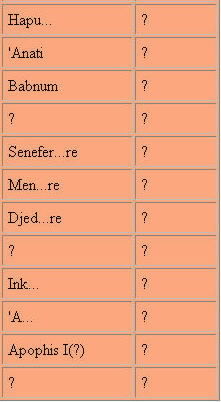 The table of Hyksos kings at this point in the XIVth dynasty shows no dates
but Apophis II is from the XV dynasty and is known to have sent 'insults'
to Seqenenre stating that his hippopotami were keeping him awake at a distance
of over 300 miles away. This is referenced on
The Widow's Son, page 1.
The last date of Seqenenre's rule
was changed in 2002 to 1554 BC but the Hyksos tables were not updated. The
table links to the site of Kelley L. Ross, Ph.D.and the rest of the dynasty work.
The table of Hyksos kings at this point in the XIVth dynasty shows no dates
but Apophis II is from the XV dynasty and is known to have sent 'insults'
to Seqenenre stating that his hippopotami were keeping him awake at a distance
of over 300 miles away. This is referenced on
The Widow's Son, page 1.
The last date of Seqenenre's rule
was changed in 2002 to 1554 BC but the Hyksos tables were not updated. The
table links to the site of Kelley L. Ross, Ph.D.and the rest of the dynasty work.
Since Avaris and Thebes were not close to each other it is quite feasable that Joseph sent Simeon and Levi to murder Seqenenre at Thebes..... And we have this;
"Egyptologists believe that during Ahmose's very early reign, little was probably accomplished and perhaps the Hyksos may have even gained some ground, recapturing Heliopolis. However, by the end of his first decade in power, we know from an Autobiography of Ahmose, son of Ibana, a naval officer from El-Kab, that he laid siege on Avaris (The tomb of Ahmose Pennekheb, another soldier also records the campaigns). This was a long battle interrupted by the need to put down insurrections in already liberated territories, but appears to have been successful sometime between his 12th and 15th year as ruler. Afterwards, he attacked the southwest Palestinian fortress of Sharuhen in a six year siege that would finally put an end to Hyksos control of Egypt".
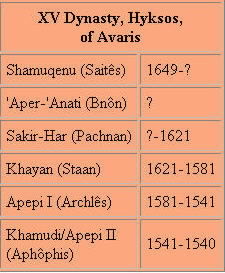 At the end of the 17th Egyptian Dynasty, at the time of Kamose, Egypt was divided
into three unrelated sections. From these divisions, there were kings at Avaris, Thebes and
Kush who negotiated commerce and trade as coequals.
At Thebes, in the temple of Amun, Kamose erected a stele expressing his
agreement with this situation saying in effect: “We
are happy with our Black Land ... the flattest lands are plowed ... cattle graze in
the marshes ... emmer is sent for our swine ... Should anyone aggress against us,
we will retaliate.” Nevertheless, bemoaning the economic restraints imposed upon him
by the king of Avaris, the Theban king resolved to end the partition complaining: “Why
should I bother contemplating my gains while there is a ruler at Avaris and a
Nubian, each one holding a portion of the Black Land and taking his slice of
the country.”
At the end of the 17th Egyptian Dynasty, at the time of Kamose, Egypt was divided
into three unrelated sections. From these divisions, there were kings at Avaris, Thebes and
Kush who negotiated commerce and trade as coequals.
At Thebes, in the temple of Amun, Kamose erected a stele expressing his
agreement with this situation saying in effect: “We
are happy with our Black Land ... the flattest lands are plowed ... cattle graze in
the marshes ... emmer is sent for our swine ... Should anyone aggress against us,
we will retaliate.” Nevertheless, bemoaning the economic restraints imposed upon him
by the king of Avaris, the Theban king resolved to end the partition complaining: “Why
should I bother contemplating my gains while there is a ruler at Avaris and a
Nubian, each one holding a portion of the Black Land and taking his slice of
the country.”
Kamose thus resented not having direct access of trade routes to Palestine and being prevented access to Nubian minerals. Monuments at Buhen exist which suggest his success in regaining control of Wawat. The Karnak stele documents in great detail Kamose’s assault on Avaris and putting the population of Nefrusy under the sword. A force was then dispatched to gain control of the oasis roads of Bahariya where a letter was intercepted from Apophis, king of Avaris, addressed to the king of Kush indicating that Avaris was already under attack. The city being heavily fortified could not be razed as Nefrusy was, but, nonetheless, its estates and orchards were plundered and stripped. In all this, its chariot-teams, bronze battle-axes, incense, oil, wood from Palestine, and precious metals along with stone were all looted. Thus Kamose returned to Thebes in triumph proving his authority had been demonstrated. This campaign would set a pattern of war to come against the Hyksos until driven out of the land. In such an atmosphere Joseph was sold into Egypt.
The “New Kingdom” of Egypt started with the 18th Dynasty and a pharaoh by the name of Ahmose. As we stated before, there are various spellings for these Egyptian names. The 18th Egyptian Dynasty brought reunification in the reign of this pharaoh Ahmose, brother of Kamose. Ahmose believed that the kings of Thebes were the legitimate successors of the Middle Kingdom whose obligation was to reunite the Black Land all the way from the Mediterranean through the Delta to and including Nubia. The war which was started by Kamose against Avaris and the occupying Hyksos was continued by Ahmose. It was a long drawn-out aggression against Avaris, and the final war was launched late in Ahmose’s reign. Some say perhaps in his 20th year. But it seems that Memphis, which appeared to be out of Kamose’s control, had finally fallen to Avaris.
Apophis and Khemudy, the last king pharaohs of Avaris, witnessed their city being attacked repeatedly by Theban marine-style assault troops as many as five different times. Each attack was characterized by savage fighting on both sides. After Avaris fell, the Theban army crossed the Sinai to besiege a Palestinian fort called Sharuhen within Hyksos territory which helped them (the Hyksos) to maintain and control the flow of commerce. After three years of siege, the Egyptians were finally victorious, slaughtering many, if not nearly all of the Hyksos. No doubt, the Egyptians also took many of the Hyksos as slaves. Thus, the Theban government regained control over trade between Egypt and Palestine. The Egyptians under Ahmose did not pursue the Hyksos on into Palestine at this time. It was some 61 years later that Thutmosis III advanced into that area. see Children of Yahweh Note: This website tries to connect Joseph with the Thebeian Kings, we show proof here he was not.
We know Ahmose reopened the Tura limestone quarries, but little survives of his construction apart form a few additions to the temples of Amun and Montu at Karnak (Thebes). However, a recent Dutch-Egyptian team of archaeologists believe they may have unearthed the remains of Ahmose's palace in the Al-Dabaa area in the Sharqiya Governorate of Egypt, a location that was probably the ancient Hyksos capital. from.. Ahmose This seems unlikely due to other compelling evidence to the contrary unless it was used after the Hyksos were defeated..
Our theory concludes that the Kings of Avaris and their religious ideas did not agree with those of the royal famlies of Thebes. Like Akhenaten, they had another God in mind, but it wasn't Aten or Ra. We think it was Baal, the Ancient Canaanite God . The antiquity of the worship of the god or gods of Baal extends back to before the 8th century BC among the ancient Semitic peoples, the descendants of Shem, the oldest son of Biblical Noah . The word Baal means "master" or "owner". In ancient religions the name denoted sun, lord or god. The myth, from.. Baal has fragments of which are on the Ras Shamra tablets, relates to the alteration of the seasons. Baal is the god of rain, thunder, and lightening. Also we find afterwards Elijah had the people slay "the prophets of Baal," thereby assuring the survival of the worship of Yahweh in Israel... Except that Baal was Yehwah and Jehovah .
Baal is still principally thought of as a Canaanite fertility deity. The Great Baal was of Canaan. He was the son of El the high god of Canaan. As we said, it is thought that he corresponded to the Hebrew god, Jehovah. He is also known as El 'Elyon, "God Most High." The cult of Baal celebrated annually his death and resurrection as a part of the Canaanite fertility rituals. These ceremonies often included human sacrifice and temple prostitution and this is associated with the Levite priests. This one defining quality tells us why Jacob almost sacrificed Issac.
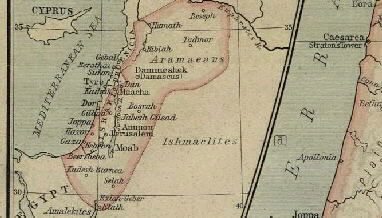 The Dynasty page says, "And while the kings did expand
Egypt up the Nile, building forts deep into Nubia, there were
none of the expeditions into Palestine or Syria by which
the XVIII and XIX Dynasties were distinguished."
This doesn't mean that at that time Egypt did not control much of the
area. Shechem is now in Samaria, just north of Jerusalem. The whole area
was called Philistines Canaan in Old Testament times.
see a Larger map
The Dynasty page says, "And while the kings did expand
Egypt up the Nile, building forts deep into Nubia, there were
none of the expeditions into Palestine or Syria by which
the XVIII and XIX Dynasties were distinguished."
This doesn't mean that at that time Egypt did not control much of the
area. Shechem is now in Samaria, just north of Jerusalem. The whole area
was called Philistines Canaan in Old Testament times.
see a Larger map
An interesting translation pops up at Genesis 35:11 - I am God Almighty. f Hebrew El-Shaddai or Lord of the Mountain. But Israel means also - 'He struggles with God'.
Yes, these are two different Gods. El-Shaddai and El 'Elyon. Later when we read about Moses we find that the God he spoke to on the mountain was El-Shaddai (or Lord of the Mountain) also known as Adon. El 'Elyon is the god of storms and war and is also known as Baal, Yehweh or Jehovah.
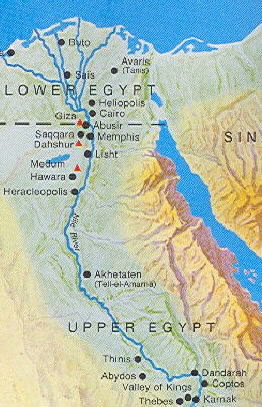 Note; Biblical theorists contend that the Hebrews were slaves
under the rule of Ramses because of a city named after him in
which the so-called slaves worked.. This
city was called Avaris 1500 years before this story was written.
This city and thousands of miles of territory around it was
ruled by the Hyksos. By the time Seqenenre was murdered, the Royal
Family of Egypt moved back to Thebes, the southern captiol of a split nation.
Note; Biblical theorists contend that the Hebrews were slaves
under the rule of Ramses because of a city named after him in
which the so-called slaves worked.. This
city was called Avaris 1500 years before this story was written.
This city and thousands of miles of territory around it was
ruled by the Hyksos. By the time Seqenenre was murdered, the Royal
Family of Egypt moved back to Thebes, the southern captiol of a split nation.
Some scholars would make Zoan (Avaris-Rameses, as they identify it) the Egyptian capital at the time of the Exodus, whereas the Bible identifies Rameses as merely a ‘storage place.’ And, in holding that Rameses II was the Pharaoh of the Exodus because of the claim that he was the builder of the city of Rameses (or, more accurately, a place called Per-Rameses), they ignore the fact that the building of the Biblical Rameses began 80 years or more before the Exodus (before the birth of Moses [Exodus 1:11 - 2:10] ), whereas historians credit Ramses II with a rule of only about 66 years...
"The term or title of “pharaoh” didn’t exist before the 15th Egyptian Dynasty.
This, in turn, implies, that because Scripture uses this term, it was written
during or after the 18th dynasty.
“PHARAOH. FAIR oh, was a title of the later kings of ancient Egypt. The Egyptians did
not call their ruler pharaoh until the Eighteenth Dynasty (1570-1300 B.C.). Even
then, pharaoh was not one of the king’s most important titles. Writers of
the Old Testament almost always used pharaoh as a title for the king of Egypt."
from Children of Yehwah
We disgree with this and we contend that 'pharoah' was
designated to the Hyksos rulers only even though the two words are used
together on two occasions. see Genesis 37:36, 39, 40,
Genesis 40: 18-19, and 41 ect, ect. which is all of Joseph's story.
However the real truth is, with the murder of Seqenenre Tao, the word king
could not be used because the vital secret king making ritual was lost. Hyksos
rulers never had the 'Word' to begin with so they were not entitled to use the
title of 'king'. This furthers our theory about 'the king that was lost'.
“The word pharaoh comes from two Egyptian words, peraa. Per-aa means great house, and at first these words described the royal palace, not the king... “In theory, the pharaoh owned all the land and people in Egypt. Scripture confirms this also as the Hyksos ruler for whom Joseph served owned all the land. In reality, the king's power was limited by strong groups, including the priests and nobles. His actions were governed by rules of conduct which the Egyptians believed the gods had set down.”
As we have now established, in verified, recorded history, Aphophis II ( 1581 BC-1550 BC ) was in opposition to the true Theban King, Seqenenre Tao II ( 1558-1554 BC ) at the time he was killed. With this came slavery of the invaders imposed by the new Theban King Kamose. Kamose is very young and is killed in battle in 1549 BC as he tries to rid the country of the 'invaders'.. We believe Seqenenre's wife took over the rule or served as co-regent with her youngest son after her husband was murdered and Kamose is killed in 1549 BC, as she is called Ahmose-Inhapi, and then changed her name to Ahhotep. Ahhotep ruled from 1549 to 1525 BC. Her son, Ahmose, was only 11 - 16 years old at the time his father was killed. The rule of these two overlapped and was shared by them but is recorded as being one ruler. see Tao II (Djehutio)(Sekenenre)
 Queen Ahhotep, mother of Ahmose I, received three
golden flies for her role in the struggle against the Hyksos.
From the Old Kingdom on foreigners were incorporated into the
army. The Egyptians possibly even signed contracts with foreign
potentates to insure the supply of mercenaries. Weni who lived
during the 16th dynasty wrote ..
Queen Ahhotep, mother of Ahmose I, received three
golden flies for her role in the struggle against the Hyksos.
From the Old Kingdom on foreigners were incorporated into the
army. The Egyptians possibly even signed contracts with foreign
potentates to insure the supply of mercenaries. Weni who lived
during the 16th dynasty wrote ..
"When his majesty took action against the Asiatic sand-dwellers, his majesty made an army of many tens of thousands from all of Upper Egypt: ...; from Lower Egypt: ...; and from Irtjet-Nubians, Medja-Nubians, Yam-Nubians, Wawat-Nubians, Kaau-Nubians; and from Tjemeh-land." Lichtheim I, The Autobiography of Weni, p. 19
Nubian Medjay entered Egypt during the turmoils of the First Intermediate Period, formed mercenary archer units and served in the armed constabulary. They are known to have fought under Kamose against the Hyksos. see Army
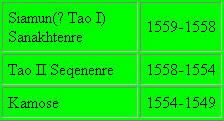 Here we have borrowed a cronology
of the Kings which shows the bloodline extending from Seqenenre to Akhenaten
and Tut. We also see Hatshepsut, who some claim was Moses wife, also
called Sheba.
Here we have borrowed a cronology
of the Kings which shows the bloodline extending from Seqenenre to Akhenaten
and Tut. We also see Hatshepsut, who some claim was Moses wife, also
called Sheba.The bloodline stopped with Tut as he had no heirs. Some say Moses was Tuthmose II and he is married to Hatshepsut, but there is no solid proof. This would also place him later, rather than earlier in the Ahmose-Kamose scenario.
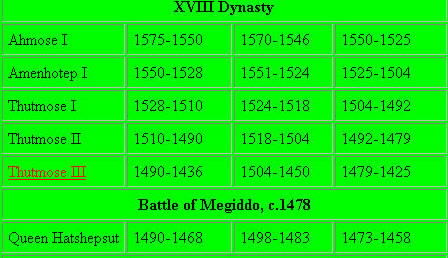
All these Kings and Queens in this table are Theban, not Hyksos.
No positively identified mummies of the female "king" or of the Great Heretic, or knowledge of their fate, has survived. Jealous or vengeful successors, Thutmose III and Haremhab, have deliberately obscured the record. The nature of Hatshepsut's frustration can be seen in the included genealogical chart. Through her ran the blood line of Kamose and Ahmose I (the brothers who mark the end of the XVII dynasty.) Second Intermediate Period
When Seqenenre was killed the secret knowledge went with him, but the successors to his throne apparently kept the 'One God' worship secret in place amoungst themselves. Moses regained the secret knowledge and carried it forward into Israel. Moses kept the worship of El Shaddai in place and there is proof in the KJ Bible this is true. Genesis 35:11. El Shaddai is a Hebrew word and corresponds with Enki the 'good' brother of El Elyon. This is recorded on stone tablets and they are called the Enuma Elish tablets that are 5000 years older than the bible. Discovered in the old Babylonia city of Nippar in the 1800's and first published in 1876, these tablets tell the story of creation and of Noah and the flood...The real story. The link to this story is available after you read Passage, page 3.
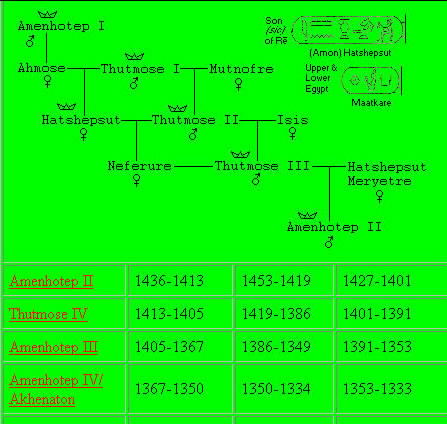 The writings of Josephus aligns with our finding that Moses leads an army
in 1549 - 1547 BC. Queen Ahhotep needed help as there were no male
leaders experienced enough to lead an army and fight. We believe
Moses was a prince and in line for rule before Ahmose. His kingly name
might have been Tuthmose, or if he was born before Ahmose, simply Mose.
We found proof he did lead an army and then
he left Egypt and was gone 40 years. Josephus writes it down.
This delayed the final expulsion of Hyksos rulers until
1544 -1540 BC under Ahmose. This is recorded in history.
We believe Moses returned to Egypt in 1507 BC. The exodus
is recorded to have began in 1456 BC, however we believe it
began in 1496 BC. This date places the arrival of the Hebrews
in Isreal to be 1456 BC. This puts 11 years between
the rule of Ahhotep ( the Queen ) and Ahmose .
This delay is historicaly recorded, but no one knew why
until now.
The writings of Josephus aligns with our finding that Moses leads an army
in 1549 - 1547 BC. Queen Ahhotep needed help as there were no male
leaders experienced enough to lead an army and fight. We believe
Moses was a prince and in line for rule before Ahmose. His kingly name
might have been Tuthmose, or if he was born before Ahmose, simply Mose.
We found proof he did lead an army and then
he left Egypt and was gone 40 years. Josephus writes it down.
This delayed the final expulsion of Hyksos rulers until
1544 -1540 BC under Ahmose. This is recorded in history.
We believe Moses returned to Egypt in 1507 BC. The exodus
is recorded to have began in 1456 BC, however we believe it
began in 1496 BC. This date places the arrival of the Hebrews
in Isreal to be 1456 BC. This puts 11 years between
the rule of Ahhotep ( the Queen ) and Ahmose .
This delay is historicaly recorded, but no one knew why
until now.
Ahmose ; He speaks as follows. I grew up in the town of Nekheb, my father being a soldier of the King of Upper and Lower Egypt, Sekenenre, the justified. Baba son of Reinet was his name. I became a soldier in his stead on the ship "The Wild Bull" in the time of the Lord of the Two Lands, Nebpehtire, the justified. I was a youth who had not married; I slept in a hammock of netting. (Urk IV 2,8 - 2,16)
 This axe was executed
to commemorate the liberation of Egypt from the Hyksos. The copper blade
together with its cedar wood handle is entirely covered with
gold and ornamented with precious stones. The inlaid decoration
of the axe is divided on each side into three compartments, all
decorated with motifs alluding to the expulsion of the Hyksos
and the re-unification of the country by Ahmose.
This axe was executed
to commemorate the liberation of Egypt from the Hyksos. The copper blade
together with its cedar wood handle is entirely covered with
gold and ornamented with precious stones. The inlaid decoration
of the axe is divided on each side into three compartments, all
decorated with motifs alluding to the expulsion of the Hyksos
and the re-unification of the country by Ahmose.
Seqenenre had tried to keep the peace with Aphophis
but the Hyksos ruler had asked for the secrets and had been
sternly refused, so he starts an insult war with
Seqenenre. Exodus 1:8 refers to the
rise of a new 'King' who did not know Joseph.
The use of the word "King" here also seems to
confirm the theory as we stated above.
The Hebrews would have not made this kind of mistake as
they were very percise when using names or descriptions.
We see the word 'Pharoah' used over and over when
describing the Hyksos rulers in the King James version.
After Seqenenre was murdered,
the elders prepared new substituted 'secret words and rituals'.
Masons will recognize this
action as being directly connected to 'todays word'.
Then Kamose stuck a finger in the
air at Aphophis by changing his name to
'Wadj-kheper-re', meaning, 'Flourishing is the
Manifestation of Re', meaning "you Failed".
Physical and Forensic Evidence
There lies in the Museum in Cairo, the mummy of King Seqenenre Tao II, catalogue 61051.
Seqenenre was found placed along-side the mummy of another man who was very tightly bandaged, then wrapped in sheepskin, which was considered ritually unclean. He was bound hand and foot and left un-mummified. This man died in pure agony because he had been cast-rated and buried alive. His head was reared back, mouth open, possibly screaming or in an attempt to breath, which he could not after the lid of the wooden coffin was sealed with pitch.
...Jubelum...?
The explanation by experts of these two mummies being placed together was that their battle was to continue in the after-life, symbolizing the legendary battle between Horus and Set. The other un-mummified man is catalogue #61023. There were three mummies, identically wrapped, indicating the same person did the work.
The Mummy of Seqenenre Tao II 
As you can see, the injuries mentioned of Seqenenre match those injuries exactly as described, of the Master Hiram Abiff. ( From the original ritual )
The forensic description by the Biertak team of the injuries is used here. The page contains some other information, as one of the wounds was in the process of healing ; meaning it was inflicted at an earlier date, therefore Seqenenre was recovering from it and we believe unable to do battle. So although there are 4 wounds shown, only 3 pertain to the actual murder. The condition of the mummy indicates it was left some time with out proper care, theory ; buried by the ruffians and not found until 3 - 4 weeks later by the Fellowcrafts. Exactly as the Legend suggests.
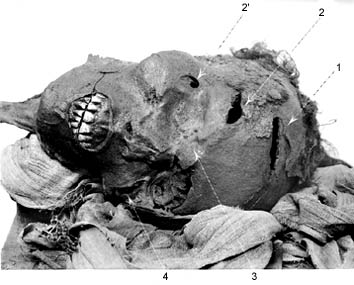 Some researchers have theorized that Seqenenre was
murdered in his sleep due to the angle of the wounds,
however the wounds could have been inflicted with
the king in a kneeling position.
Experts say the wounds are not consistant with battle field injuries.
Confirmation of this evidence comes from... Egyptian
Miscellany .."The Austrian scholar Manfred Biertak and his
Czech colleague Eugen Strouhal who studied the wounds
in Seqenenre's skull in the 1970s and demonstrated to their own satisfaction
that the injuries were inflicted by bronze weapons of a purely
Hyksos design"...."but Seqenenre's wounds must have
been inflicted at two different times -- and the second
resulted in his death." see
Seqenenre
(click A to Z then S.. updated - this is not the Biertak summation, however
it is below. Department of Pathology, Vrije Universiteit Medical Centre,
De Boelelaan 1117, 1081 HV Amsterdam, The Netherlands; Bietak M, Strouhal E.
Die Todesumstände des Pharaos Seqenenre (17. Dynastie). Ann Naturhistor Mus
Wien 1974;78:29–52 as follows:
Some researchers have theorized that Seqenenre was
murdered in his sleep due to the angle of the wounds,
however the wounds could have been inflicted with
the king in a kneeling position.
Experts say the wounds are not consistant with battle field injuries.
Confirmation of this evidence comes from... Egyptian
Miscellany .."The Austrian scholar Manfred Biertak and his
Czech colleague Eugen Strouhal who studied the wounds
in Seqenenre's skull in the 1970s and demonstrated to their own satisfaction
that the injuries were inflicted by bronze weapons of a purely
Hyksos design"...."but Seqenenre's wounds must have
been inflicted at two different times -- and the second
resulted in his death." see
Seqenenre
(click A to Z then S.. updated - this is not the Biertak summation, however
it is below. Department of Pathology, Vrije Universiteit Medical Centre,
De Boelelaan 1117, 1081 HV Amsterdam, The Netherlands; Bietak M, Strouhal E.
Die Todesumstände des Pharaos Seqenenre (17. Dynastie). Ann Naturhistor Mus
Wien 1974;78:29–52 as follows:
Among the cache of royal mummies found in 1881 at Deir el Bahri was the damaged and poorly embalmed body of Seqenenre Tao, a ruler of Luxor during the troubled Seventeenth Dynasty. One of his sons, Kamose, is credited with the final expulsion of the foreign Hyksos rules; another, called Ahmose, founded the Eighteen Dynasty and became the first pharaoh of the New Kingdom. The Austrian scholar Manfred Biertak and his Czech colleague Eugen Strouhal studied the wounds in Seqenenre's skull in the 1970s and demonstrated to their own satisfaction that the injuries were inflicted by the bronze weapons of a purely Hyksos design. Did Seqenenre therefore meet his death in battle?
In July 1881, Emil Brugsch discovered the mummy of Pharaoh Ramesses II, in the same cache was another royal corpse, some 300 years older than that of Ramesses, and distinguished by its particularly putrid smell. According to the label, this was the body of Seqenenre Tao, one of the native Egyptian rulers forced to live far to the south in Thebes during the Hyksos period, and as was obvious even to the untutored eye, Seqenenre had met a violent end. The middle of his forehead had been smashed in … Another blow had fractured his right eye socket, his right cheekbone and his nose. A third had been delivered behind his left ear, shattering the mastoid bone and ending in the first vertebra of the neck. Although in life he had clearly been a tall and handsome young man with black, curly hair, the set expression on Seqenenre’s face showed that he had died in agony. After death he appears to have fared little better, as his body seems to have been left for some while before mummification; hence the putrid smell and signs of early decomposition.
Egyptian records are silent on how Seqenenre met his end, but almost certainly it was at the hands of the Hyksos/Canaanites.’
Historical records are helpful, but not conclusively so. We know that Seqenenre Tao came into open conflict with the Hyksos king Apophis who wrote a letter to the Luxor ruler saying that the hippopotamuses in Luxor were making such a commotion that he could not sleep. 'Hippopotamus' is thought to have been intended as a derogatory term that referred to Seqenenre himself and his two sons. Military confrontation was inevitable. And not only his two sons, but also his wife, Queen Ahhotep, appear to have been involved, for one of his sons later gave her the award of three golden flies, the the highest honour for military valour. The letter is on Widow's Son 2."Insults"
The exact sequence is unclear, but Seqenenre's wounds must have been inflicted at two different times -- and the second resulted in his death. One of his arms was paralysed, which could well have been caused by the injury to his head, where the skull showed evidence of healing. But did Seqenenre die at the hands of an assassin, as some argue, or on the field of battle? Manfred Bietak's theory holds that the angle of the various wounds confirms that the king died on his knees, no doubt fighting to the last.
It was also abundantly clear that the un-mummified man had done something that was unforgivable to the extreme and he was to be cursed and tortured even in death. The mummy of the murderer is on Abraham's second page.
In the Pyramid Texts, we find Osiris
who is cut into 14 pieces and these parts
scattered all over the country that is now called Africa.
We always see a reference to his left eye being cut out and
other pieces of his body cut in twain. This identifies Sequenere
with Osiris as a mortal who is brutally murdered and is
resurrected to be King of the 'underworld'. It also
explains the parts of the third degree, pertaining to what some call the
'bloody oath'. Even though dead, he remains alive in
the 'afterlife'.
"Yet He were dead, so shall He live".
Even if the Knight and Lomas account is proven false, we feel there is a connection that exists due to the immediate overthrow of the Hyksos in this time period, the emergence of Moses in 1590 BC. as the "Prince of Egypt" and the fact that he studied under Egyptian Priests and was in the kingly line, destine to become a Ruler. We feel Moses lived under the same roof as Seqenenre Tao. If the 'word' was whispered to him on the mountain, it had to have been lost during his lifetime. But we found a completely different story as to how Moses got the 'word'. However it was, this makes the transfer of power back to the Olai complete. His birth, possibly recorded in 1590 BC., could be verified by a triple star conjunction. (see our page, The Magi - Astronomy of the Ancients.) This type of star alignment signifies "holy birth", as it did the birth of Jesus, however Jesus' birth was not on Dec. 25th, nor was it in 1AD.
Seqenenre's death in 1554 BC. places Moses under
Ahhotep ( the Queen ) leading an army at age 36.
This dating indicates Ahmose II was 16 years
old - Ahmose 1549 BC - 1525 BC..
from..
XVIIIth Dynasty 1570 - 1293
( Thebes )
Tetisheri was a queen during the 17th Dynasty in Thebes, and was the commoner wife of Ta'o I (date unknown). She has been called the "mother of the New Kingdom" because of her influence over its founders, her son (To'a II) and grandsons ('Kamose' and 'Ahmose'). As for Queen Ahhotep whose burial was found intact, all the military hardware agrees with Ahmose's thanksgiving inscription made for his mother, in which he credits her with having taken charge of the kingdom after her husband's untimely death (Seqenenre Ta'aa I ), and also having taken charge of the army, and taken part in the suppression of several rebellions. The Queen took her husband's name or changed it to reflect undisputed rulership. Ahhotep II - 18th Dynasty. from..Tetisheri
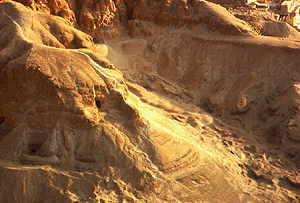 Ahhotep was a powerful queen. An ambiguous sentence on
a stela devoted to her indicates that she may even have
rallied troops: "She is the one who has accomplished the
rites and taken care of Egypt... She has looked after her
soldiers, she has guarded her, she has brought back her
fugitives and collected together her deserters, she has
pacified Upper Egypt and expelled her rebels".
Seqenenre and Ahhotep had two sons, Kamose and Ahmose,
whom they taught to dream of defeating the Hyksos.
Ahhotep was a powerful queen. An ambiguous sentence on
a stela devoted to her indicates that she may even have
rallied troops: "She is the one who has accomplished the
rites and taken care of Egypt... She has looked after her
soldiers, she has guarded her, she has brought back her
fugitives and collected together her deserters, she has
pacified Upper Egypt and expelled her rebels".
Seqenenre and Ahhotep had two sons, Kamose and Ahmose,
whom they taught to dream of defeating the Hyksos.
Ahhotep II was the daughter of Ahmose I and Ahmose-Nefertari and was the wife of the 18th Dynasty king Amenhotep. These Dynasty 17-early 18 queens had no qualms at all about taking command and leading armies if needed. That is what indeed gave the Theban Kingdom the success in the rebellion against the Hyksos. Both Tao II plus Seqenenre's wife, Queen Ahmose-Inhapi, were discovered in 1881 by Emil Brugsch in the royal cache at Deir el Bahri.DB-320
Egyptian legend says, 'The Word' was given to Isis, in Egypt, just before Ra, the Sun God died. She then passed it to Horus; However, God took the most powerful devine secret away from the followers of the Osiris cult, as we have discovered, when Seqenenre was murdered, but it remained with the 'initiates' of the true 'Brotherhood of Man', passed on to the Prince of Egypt, Moses. There is a connection between Horus and Hiram Abiff, and there is a connection between Gnostic and Egyptian religious beliefs. The connection of these brilliant men who all became bible heroes are the real story. Bible legends try to convince us men like Enoch, Noah, Abraham, Moses, Solomon and Jesus were uneducated and poor. We found that their scientific, mathmetical, alchemical and 'magical' knowledge is actually the reason they knew and were able to communicate with God.
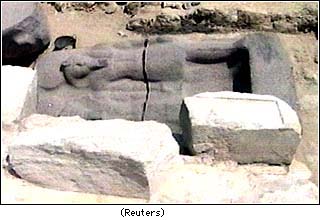 In other writings we have found information that
leads us to believe that Ramses II discovered the Emerald Tablets
of Thoth and their secret. He secretly worshiped One God. In
1996 an 11 foot tall, double sided statue was found depicting
him as himself and Re-Harakhti, the sun god. "Ramses was a
preserver and restorer of the Sphinx, and that explains to us
the unique form of the statue which shows Ramses as the pharaoh
and then with the disk of the sun as the god Re-Harakhti of the
Giza Plateau," Ali Hassan, undersecretary of state for
archaeology .
In other writings we have found information that
leads us to believe that Ramses II discovered the Emerald Tablets
of Thoth and their secret. He secretly worshiped One God. In
1996 an 11 foot tall, double sided statue was found depicting
him as himself and Re-Harakhti, the sun god. "Ramses was a
preserver and restorer of the Sphinx, and that explains to us
the unique form of the statue which shows Ramses as the pharaoh
and then with the disk of the sun as the god Re-Harakhti of the
Giza Plateau," Ali Hassan, undersecretary of state for
archaeology .
August 5, 1996 Web posted at: 12:45 a.m. EDT
GIZA PLATEAU, Egypt (CNN) -- Archaeologists last week unearthed a unique 3.5-ton pink granite statue believed to portray Ramses II, one of ancient Egypt's most illustrious pharaohs.
They made the discovery during routine excavations, literally stumbling onto the statue after months of work around the foot of the pyramid of Mycerinos. The statue is more than 11 feet tall, and portrays Ramses two ways: as king and as Re- Harakhti, the sun god.
The incomplete double-headed statue was sandwiched between limestone bricks and coated in centuries-old dust and sand in what archaeologists believe was an ancient workshop.
Just as Akhenaten's
monuments were destroyed, the Ramses II's statue was buried to
hide his 'One Sun God' belief. There is nothing left of Seqenenre's
history of rule, therefore we believe he too worshipped ONE GOD.
His name 'Tao' means "THE WAY".
We have proof here that a 'Master' was indeed murdered. His name was 'Tao'. He fits every description of the murdered Master Hiram, including his being lame. Also through our research, we have found a story that explains better 'the deathless body' and it is not allegorical. The teachings were meant to hide the secrets from the uninitiated. We found that Jesus used many allegorical teachings for the same reason. Only the disciples were taught and understood the teachings. 'Raising Lazarus from the dead' has hidden meaning which can be explained the same way as the raising of Hiram Abiff or 3rd degree Master Masons of today.
On this manner, through good wit of geometry,
Began first the craft of masonry;
The clerk Euclid on this wise it found,
This craft of geometry in Egypt land.
The entire translation is here...
THE REGIUS MANUSCRIPT
"Here begin the constitutions of the art
of Geometry according to Euclid." Greek geometrician, who taught
in Alexandria under the reign of Ptolemy I (323-283B.C.). He is
the author of the Elements, the basis of plane geometry.
Many years after, the good clerk Euclid
Taught the craft of geometry full wonder wide,
So he did that other time also,
Of divers crafts many more.
Through high grace of Christ in heaven,
He commenced in the sciences seven;
Grammar is the first science I know,
Dialect the second, so I have I bliss,
Rhetoric the third without doubt,
Music is the fourth, as I you say,
Astronomy is the fifth, by my snout,
Arithmetic the sixth, without doubt,
Geometry the seventh maketh an end,
For he is both meek and courteous,
Grammar forsooth is the root,
Whoever will learn on the book;
But art passeth in his degree,
As the fruit doth the root of the tree;
And music it is a sweet song;
Astronomy numbereth, my dear brother,
Arithmetic sheweth one thing that is another,
Geometry the seventh science it is,
That can separate falsehood from truth, I know
These be the sciences seven,
Who useth them well he may have heaven.
When the craft is practiced, it still represents
a cleansing and purification of the soul of the candidate or
'initiate'.
Make no mistake, This is exactly like one of the ceremonies
used in Egyptian legend, known as "Making
the Transformation into the god who Lighteneth the Darkness".
Performed for the living, as part of the initiation, this ritual makes the
'Soul see the Light'. The Light is Truth. Truth Lights
the Darkness, and makes an end to it. The soul is then brought
into the Hall of Maati, where it is "separated from every sin
which he hath committed, and may behold the faces of the Gods".
This separation describes and contains the Ten
Commandments in their original complete form, and others that were
required to be free of sin. One could not cross over to be Osiris,
to eternal life without the repeating of the 'Chapters' of Life.
[ described in the Egyptian Book of the Dead, page 42 ]
A resemblance of this ritual and the 'Magic words' were used
in the time of Jesus. It was a 'Secret Doctrine' known only to
the 'Initiates' and preformed only by the High Priest.
( Scripture in the Book of Matthew proves this.) This was not
occult teaching then and it isn't now. Anyone who uses
the word 'occult' to describe masonry as evil is an outright lier.
The word means, 'to conceal', 'not revealed', 'secret'. It also
could mean supernatural or 'magical' power, but the last person
to use that power by the grace of God, was Jesus.
Read Matthew 13:11, when Jesus says, " The knowledge of the secrets of the kingdom of Heaven has been given to you,( the disciples ) but not to them." People living outside the closed community of Qumran, near the Dead Sea, were not familiar with this, not allowed admission, and according to Peter, in the Nag Hammidi writings, remained ignorant.
These Egyptian rituals are not used today, but should be
studied in depth as they were the beginnings of the craft taught
by Thoth. These teachings were given to the 'Sons of Light'
and passed down as the 'Laws of Moses'.
In the beginning, the Egyptian story is that Thoth is
said to have been taught these works by the Gods and he then wrote them down.
Thoth is connected to Enoch and we will show you why. Thoth knows
the names of ALL the Gods. He describes 'passwords' necessary to
enter into each kingdom in Heaven.
The Hebrew story and the Egyptian story are exactly alike
Seth, the good son (of Adam) is possibly represented as Horus.
Osiris or Ra is God. Cain would be represented as Set or Baal, the evil one.
Cain is depicted as a human, Baal is depicted as an evil god.
Isis is very important in our theory. Isis may represent
Sophia/Eve or 'wisdom'. Sophia is not human but Eve was.
The ancient gods and goddesses of Egypt are part of an
older story that is much more truthfull than we have been taught.
But because our present day bible is susposedly based on
the Hebrew account, and these gods were considered evil by
Hebrew writers, we have a heretical view of them.
But if you compair the stories involving Isis, Osiris and Horus with
the Virgin Mother and her son, they are exactly alike. The Bible
tells us that Eve and Mary conceived a son by divine origin. Then we
discovered there are several more, much older 'Virgin Mothers'.
Sophia who was also known as God's wife is actually the first creation of God. What we discover in the Nag Hammidi texts is that without her, the world as we know it would not exist, neither would their son - The Christ. This story comes to life on the 2nd Passage page as we reprinted part of the Nag Hammidi writings.
Moses, as the first High Priest of the Hebrews, wrote the first 5 books of the bible as commanded by God. At least that's what we've been told. Did he get these stories from Enoch? Farther into the site, this connection and the similarities of the stories become quite clear. We find that the stories actually came from a much older tradition which involves beings called "The Watchers". These beings are described in Genesis and Enoch's secret books and they are the key to our present form of judgemental, 'serve and obey', 'Fear God' religion.
These "Watchers" have alot more to do with the creation of mankind than we have been taught. If you've seen this verse.. "The man has now become one of US, knowing good and evil". Genesis 4:22, We will show you the all important clue to the secret and the many other hidden secrets of Genesis because Genesis 6: 1-7 is not in the correct place in the story. The Nephilim, children of the (Watchers) were here first, before Adam.
The authors of Genesis seem have picked up part of their story from Hindu legends of the creation and early history of humanity. Stories of Hindu heros Adimo, Heva, Sherma,, Hama and Jiapheta apparently were replicated into legends about Adam, Eve, Shem, Ham, and Japeth. The clay tablets of Babylon found to be over 5000 years old, tell yet another story that does not agree with Genesis. Archeology has 'dig up' something out of the past that tells the real story of Adam and Eve. Edited for your benefit - or rather their's. What if what you thought was true really isn't?
And what about the contridictions we keep finding in the
KJB? Why are there two lists of the descendents of Cain and Seth
with practically the same names? Why is there no wife's name
mentioned for Cain and Abel? And why do religious theorists
contend that Nimrod was the reason men turned to evil?
Why does Ezekiel mention great 'chariots of fire' that he
was taken to Heaven in? What was it really? We found the answer.
Please read the 'Passage of the Secrets' pages. What we have theorized will be abundently clear from there. Historical and archeological proof of a different story than what you've been taught may change your mind about organized 'serve and obey', 'fear of God' religion.
![]()
When Adam took that first bite of the fruit of the tree of knowledge, the bible says
God was angry. But a controlling jealous enity is really responsible. In most parts of the world
this enity still has control over 'god fearing' ignorant humans. Spurred on by a church that
capitolized on this 'control' idea, the money making slavery of mankind by this church and it's
offspring has never stopped. We feel understanding the ancient well documented historical
truth of how life was brought to Planet Earth and the deeper implications of this truth will
teach you how this thing that makes humans hate each other can never control you again. The
heresy is not ours nor was it part of our history until the
church and this huge cover-up made it so.
All of this is revealed on the first
Passage Forward page.
Search this site
Our search Engine does not search for the links in this site, only words in the text.
View My Guestbook
 Sign My Guestbook
Sign My Guestbook
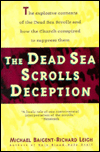 New Information has surfaced on the Dead Sea Scrolls.
When they were discovered the scholars involved are all
Christian ( mostly Catholic ) Theologins. They have
delibertly withheld scroll
publication for 35 years due to 'the explosive content'. One such
scholar has become a recluse in Paris and has scrolls in his
possession that he refuses to allow any study or photographs
be taken of. They apparently reveal the 'secret life and
teachings' of Jesus that do not agree with current christian
dogma. They reveal the life style of the Essene community where
Jesus grew up. The book shown reveals the deception in the NT.
New Information has surfaced on the Dead Sea Scrolls.
When they were discovered the scholars involved are all
Christian ( mostly Catholic ) Theologins. They have
delibertly withheld scroll
publication for 35 years due to 'the explosive content'. One such
scholar has become a recluse in Paris and has scrolls in his
possession that he refuses to allow any study or photographs
be taken of. They apparently reveal the 'secret life and
teachings' of Jesus that do not agree with current christian
dogma. They reveal the life style of the Essene community where
Jesus grew up. The book shown reveals the deception in the NT.
FLASH! The Great Pyramid and it's connection to Masonry
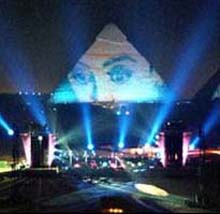 Biblical Scholars have discovered that the
Great Pyramid of Gaza was God's hiding place, for "The secret
Knowledge" , and it was the first Holi Temple of God.
( made with hands )
Biblical Scholars have discovered that the
Great Pyramid of Gaza was God's hiding place, for "The secret
Knowledge" , and it was the first Holi Temple of God.
( made with hands )
Mason's in Europe seem to know
this.
An amazing fact is that the inside measurement of the Coffer in The Great Pyramid is the exact measurement of The Ark of the Covenant. More facts related to the ancient Masonic order emerge on the 'Ark of the Covanant' and the 'Pyramid page'.
And...Read about the amazing events of Dec 31, 1999 as the capstone for the Great Pyramid was within weeks of being replaced on the 10,500 year old 7th and only remaining wonder of the world'. The Hermetic Tradition and the main page.. Robert Bauval. Robert covers some Hermetic subjects, which are directly linked to Masonry. And an article on 'The Star of Bethlehem' [ The Star of Jesus has reappeared.] The page is definately worth a visit.
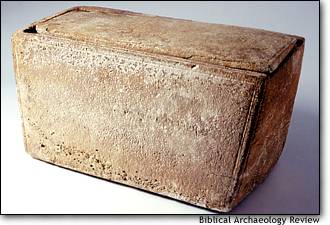 NEWS FLASH, October 22nd, 2002; The discovered "box" with writing that described it's
former contents as 'containing the bones of James' is on Jesus Discovered page 3. This
box links James to Joseph and Jesus and is possibly the first documented archaeological
proof of the existence of Jesus.... But we believe this is a hoax created just in time for
the release of a book.
NEWS FLASH, October 22nd, 2002; The discovered "box" with writing that described it's
former contents as 'containing the bones of James' is on Jesus Discovered page 3. This
box links James to Joseph and Jesus and is possibly the first documented archaeological
proof of the existence of Jesus.... But we believe this is a hoax created just in time for
the release of a book.
NO PART OF THIS SITE MAY BE COPIED OR REPRODUCED, IN WHOLE OR IN PART WITHOUT THE EXPRESS WRITTEN APPROVAL OF THE WEBMASTER. © COPYRIGHT 1999 - 2009 C.I.C...ALL RIGHTS RESERVED.
Please, If your site is not Masonic in nature, we kindly ask that you do not link here without permission or under the guidelines set forth here... see Legal IssuesThis page has been visited times since Nov. 21st 1999.